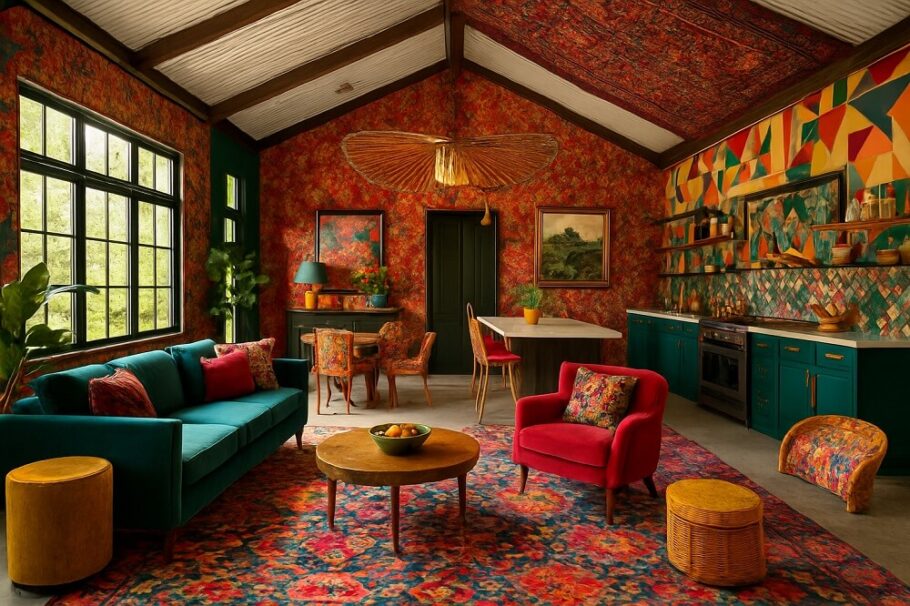Barndominiums are no longer just functional metal buildings converted into cozy living spaces—they’ve become architectural canvases where personal style takes center stage. While the minimalist “modern farmhouse” look once dominated the barndo aesthetic, a new movement is on the rise: maximalism. Characterized by fearless color, layered textures, and eclectic patterns, the maximalist barndominium celebrates individuality and abundance in design.
If minimalism whispers, maximalism roars. And when that philosophy meets the vast, open-plan interiors of a barndominium, the results are nothing short of spectacular. This post explores how maximalist design principles translate beautifully into large metal-frame homes, offering practical tips and creative strategies for homeowners ready to embrace the “more is more” mantra.
1. Understanding Maximalism in the Barndominium Context
Maximalism is more than just decoration—it’s an expression of personality through the environment. It rejects restraint and instead celebrates visual richness, storytelling, and layering.
In a barndominium, where square footage often comes in generous supply and the structural framework provides expansive wall and ceiling surfaces, maximalism finds a natural home. The metal shell’s simplicity becomes a blank canvas for dramatic interior statements—vibrant wallpapers, bold art, richly patterned rugs, and high-contrast furnishings.
Unlike clutter, which results from disorganization, maximalism is curated abundance. Every object, fabric, or hue contributes to a visual narrative. The open concept typical of barndominiums allows these layers to breathe, keeping the space energizing but not overwhelming.
2. Why Maximalism Works So Well in a Barndominium
The success of maximalist interiors in barndominiums comes down to balance—between volume, color, and light. Here’s why this pairing feels so right:
- Large spaces need personality. The soaring ceilings and wide-open layouts of barndos can sometimes feel cavernous. Maximalism adds warmth, rhythm, and intimacy through bold visual layering.
- Metal structures create contrast. The industrial elements—exposed beams, corrugated panels, and steel frames—form a striking backdrop for plush textiles and ornate details.
- Flexibility in zoning. Maximalist decor helps define zones in an open-plan barndo. Patterned area rugs, distinct wall treatments, or unique color schemes can differentiate the kitchen, dining, and lounge spaces.
- High ceilings amplify drama. Whether through large art pieces, massive chandeliers, or colorful ceiling treatments, vertical volume enhances the “wow” factor that maximalism thrives on.
In essence, maximalism fills the emptiness that minimalism leaves behind.
3. The Building Blocks of a Maximalist Barndominium
- Bold Color Palettes
Maximalist color schemes are unapologetically rich and saturated. Think emerald green against deep navy, or ruby red with gold accents. In a barndominium, these colors can be used strategically to ground vast spaces.
- Walls: Jewel-toned paints or patterned wallpapers make excellent feature walls in large living areas.
- Ceilings: Don’t neglect this surface—painting a ceiling in a contrasting color or adding decorative beams enhances spatial drama.
- Trim and Doors: Glossy black trim or brightly painted doors can turn architectural elements into art pieces.
Pro Tip: Anchor bold colors with natural materials—leather, wood, and stone—to maintain a sense of warmth amid visual intensity.
- Patterns and Textures Everywhere
Patterns are central to maximalist design. Layering stripes, florals, geometrics, and abstracts gives the space rhythm and vitality.
In a barndominium:
- Floors: Patterned tile, ornate rugs, or stenciled concrete slabs can create visual boundaries.
- Walls: Murals, wallpaper collages, or wainscoting in contrasting tones add dynamic depth.
- Furniture: Mix velvet upholstery with rattan, silk, and metal finishes to create textural interplay.
Rule of thumb: If you’re mixing three or more patterns, vary their scale—pair large florals with small geometrics and medium stripes for balance.
- Art as Architecture
Because barndominiums often feature tall walls and minimal structural interruptions, artwork can play a commanding architectural role.
- Oversized canvases or gallery walls can dominate a living area.
- Sculptural pieces or mixed-media installations can fill vertical voids between beams.
- Even the barn doors themselves can be hand-painted or fitted with stained glass for a statement.
Art transforms the vast emptiness of a metal wall into an emotionally charged focal point.
- Furniture That Tells a Story
Maximalism loves narrative—each piece of furniture contributes to a larger story of comfort and personality.
- Combine vintage and modern: A mid-century armchair beside a Rococo cabinet creates delightful tension.
- Use unexpected proportions: Oversized sectionals, grand pianos, or dramatic canopy beds fit naturally in the generous volume of a barndominium.
- Incorporate found objects and heirlooms: They add authenticity and visual intrigue.
The furniture layout should invite exploration—every angle offering a new surprise.
4. Balancing Scale and Saturation
In a space as large as a barndominium, one challenge of maximalism is maintaining coherence. Without thoughtful design, bold choices can compete rather than complement.
Here are a few strategies:
- Use repetition: Repeat key motifs—such as a color, shape, or pattern—throughout the space to unify the composition.
- Create resting zones: Balance intense visual areas with neutral or monochromatic zones where the eye can rest.
- Play with lighting: Layered lighting—ambient, task, and accent—controls how colors and textures reveal themselves across the day.
Example: A barndominium great room might feature a deep green wall, patterned Persian rug, and colorful art, but offset by neutral linen sofas and warm wood beams to avoid sensory overload.
5. Maximalism Meets Modern Metal Structure
The structural DNA of a barndominium—steel framing, open trusses, and large-span spaces—presents both opportunities and challenges for maximalist decor.
- Exposed steel beams can be painted in bold hues or wrapped in reclaimed wood for contrast.
- Metal walls can host patterned acoustic panels or decorative cladding to reduce echo while adding visual richness.
- High clerestory windows allow maximalist interiors to stay bright, preventing deep colors from feeling too heavy.
- Lofted spaces can double as art galleries, libraries, or music corners, enhancing the layered feel of the design.
In essence, the industrial barndominium shell provides the perfect stage for theatrical interior expression.
6. The Maximalist Kitchen and Bath
These functional areas often become design showpieces in maximalist barndos.
Kitchen:
- Use colorful cabinetry—cobalt blue, mustard yellow, or deep burgundy.
- Mix metals—brass hardware, copper sinks, and black steel lighting fixtures.
- Install patterned backsplash tiles that act like murals.
- Combine open shelving with vintage china or statement glassware displays.
Bathroom:
- Try bold wallpaper or mosaic tile.
- Choose a freestanding tub in an unexpected color.
- Incorporate gold fixtures or antique mirrors for decadence.
These details transform utilitarian spaces into sensory experiences.
7. Sustainability Through Sentimentality
Interestingly, maximalism aligns well with sustainability when done thoughtfully. By reusing, repurposing, and collecting meaningful pieces instead of buying mass-produced items, homeowners reduce waste.
A maximalist barndominium can be both eco-conscious and expressive, with upcycled furniture, reclaimed wood finishes, and heirloom decor blending into a timeless, non-disposable aesthetic.
8. Outdoor Extensions of the Maximalist Spirit
Barndominiums often feature large porches or connecting patios—prime areas for extending the interior’s boldness outward.
- Use patterned outdoor rugs, colorful Adirondack chairs, and abundant planters.
- Consider mismatched patio furniture with coordinated cushions.
- Incorporate string lights, lanterns, and outdoor art for ambiance.
Even the landscape can follow maximalist cues: lush, layered planting rather than manicured minimalism.
9. Avoiding Common Maximalist Pitfalls
While maximalism embraces abundance, it thrives on intention. To keep the space inspiring rather than overwhelming:
- Edit regularly. Rotate collections and decor seasonally to maintain freshness.
- Keep pathways open. Don’t block natural circulation in large open spaces.
- Trust your instincts. If a combination makes you smile, it belongs.
Remember—maximalism is about joy, not chaos.
10. The Emotional Impact: Living with “More”
At its core, the maximalist barndominium is not about showing off possessions—it’s about living surrounded by what you love. The bold colors stimulate creativity, the eclectic textures evoke curiosity, and the layered storytelling fosters connection.
In a barndominium, where form follows freedom, this design philosophy turns the vastness of space into a canvas for personality. Whether you’re displaying a gallery of vintage neon signs, layering Moroccan rugs under a crystal chandelier, or painting your pantry fuchsia, maximalism celebrates the courage to be unapologetically yourself.
Conclusion: The Joy of Abundance
The maximalist barndominium is the antithesis of the sterile, cookie-cutter home. It’s a space where architectural freedom meets expressive interior art—a place where every square foot vibrates with color, culture, and comfort.
So if you’re designing or renovating a barndominium, dare to go bold. Let pattern meet pattern, color clash with joy, and every corner tell a story. Because in a space as vast as a barndominium, there’s room for everything you love—and then some.

